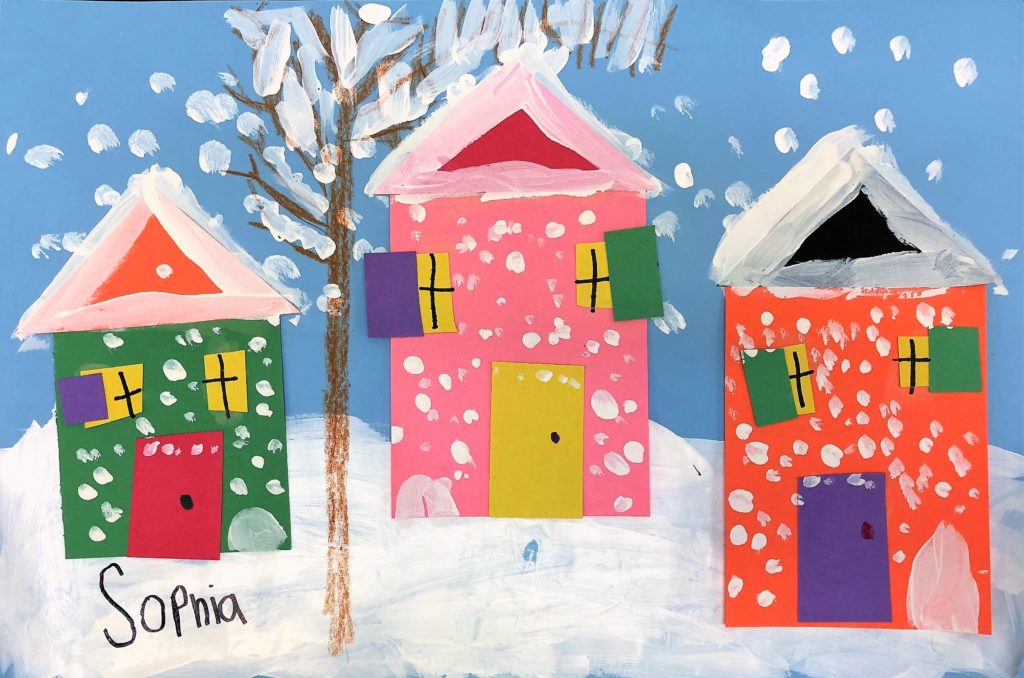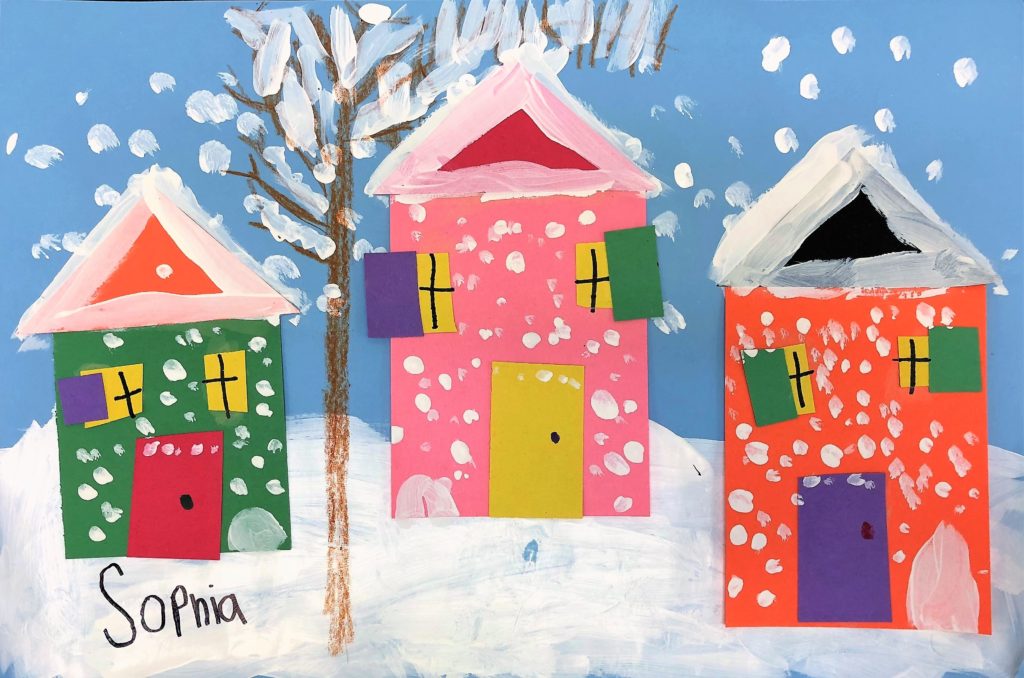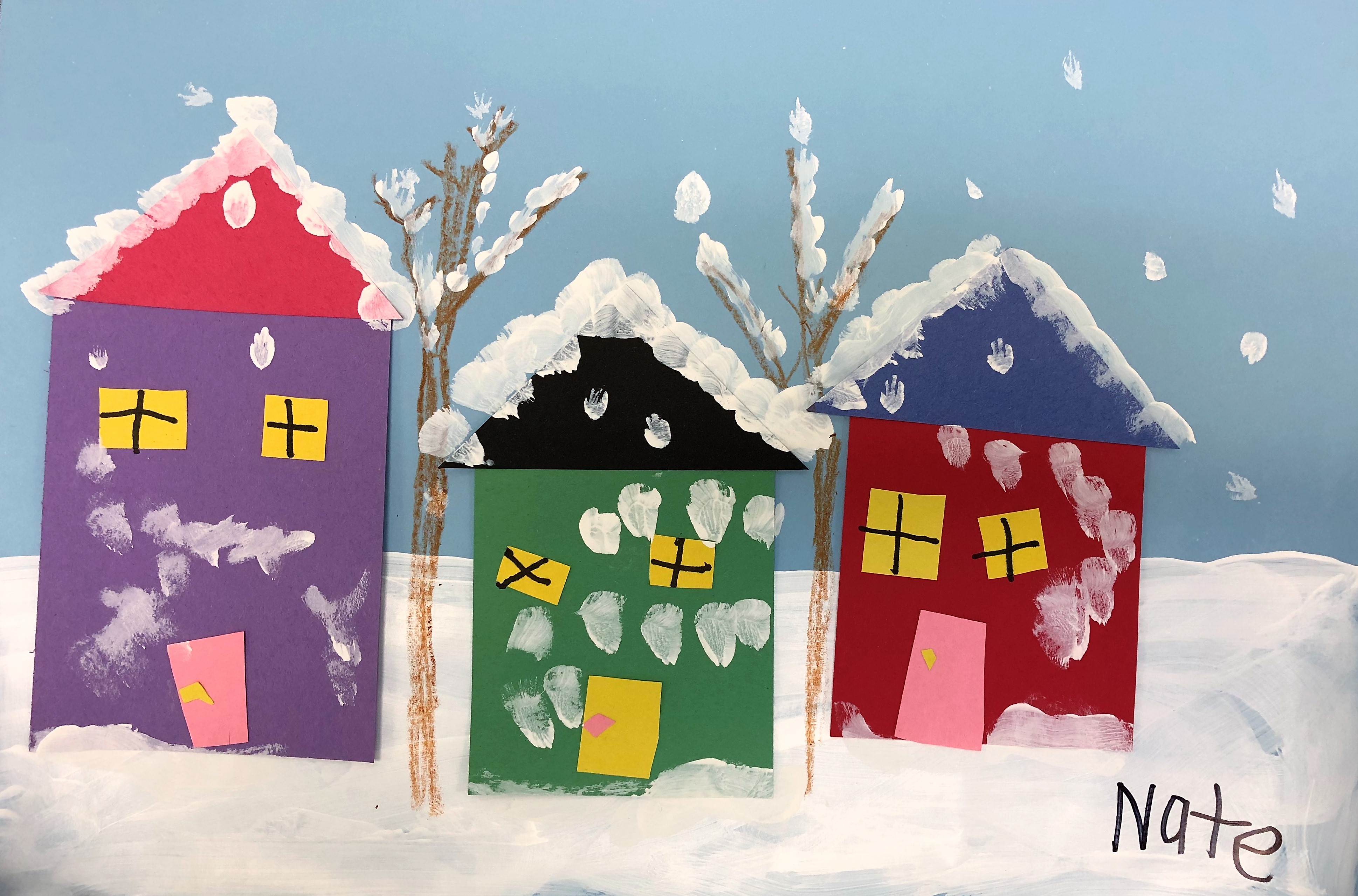
Grandma Moses Winter Houses is the perfect cozy project for Kindergarten students. It combines language arts, history, math and science. This project covers Common Core Standards for Science and Language Arts for grades K-1 which can be found at the end of the lesson.
Grade Level
Kindergarten, 1st, and 2nd grade. This project was created by Kindergarten students.
Objective for Grandma Moses Winter Houses
Elementary aged students will create a winter scene with three houses in while learning about art master, Grandma Moses.
Time
4 – 30 min lessons
Materials
- Brown Crayon or oil pastel
- Black Sharpie Marker – Sharpie Permanent Marker, Fine Point, Black, Pack of 5
- Light blue paper – PACON – 103063 Pacon Tru-Ray Construction Paper, 12-Inches by 18-Inches, 50-Count, Sky Blue (103048)
- Brushes – Acrylic Paint Brush Set, 1 Packs / 10 pcs Nylon Hair Brushes for All Purpose Oil Watercolor Painting Artist Professional Kits
- White acrylic paint – Crayola Artista II Washable Tempera Paint 16oz White
- Variety of colored construction paper – Tru-Ray Heavyweight Construction Paper Pad, 10 Assorted Colors, 9″ x 12″, 40 Sheets
- Scissors
- Glue Sticks
- Q-tip
Inspiration/Artist
I made this project from Artteachersmile: Click Here
Instruction with Questions
First
Read the book, “Wendy’s Winter Walk: Speech Sounds W, M, P, B (Phonological and Articulation Children’s Books)” by Cass Kim M.A. CCC-SLP (Author), Kawena K (Illustrator). This is a great language support for young learners and has beautiful wintery illustrations. It is a wonderful reference for winter houses and where the snow falls.
Read the Book, “The Year With Grandma Moses,” by W. Nikola-Lisa.
Show the students background on Grandma Moses.
Grandma Moses. Brief biography and artwork. Great for kids and esl: Click Here
Women Artists: Grandma Moses: Click Here
Second
This project is perfectly shown in this image from a site that has since been taken down but is connected with this awesome art teacher on Facebook @artteachersmile.

Third
I pre-cut houses in approximately 4.5×4.5 size and 4.5×5.5. The roof of each house was approximately 3.5×3.5 cut across the diagonal. I also had on hand a variety of chimney pieces and window shutters as requested.
I am sad to say that all of my photos as students worked on this project exist no more. However, I think the main image from Art Teacher Smile says it all.
Paint a horizon line, fill it in and polka dot some snow. A Q-tip is a great tool for this. Or using a splatter paint technique is fun also.
Fourth
After the houses are glued down, show them how to make a tree using a brown crayon or oil pastel.
I put up a number five in the air with my hand and say…this is not a tree. Hahaha. Then I walk them through the steps I found on EasyDrawingGuides.com – Click Here. Show them the letter V. It all “grows” from there.

Fifth
Finally, have them add details to their houses and snow on their trees, rooftops and even a little mound of snow in front of each house. I wish I had more photos to share but these are the only ones that survived the winter.
Check out these finished Grandma Moses Winter Houses art pieces!



Common Core Standards for Grandma Moses Winter Houses Art
Kindergarten – Math
Geometry
Identify and describe shapes (squares, circles, triangles, rectangles, hexagons, cubes, cones, cylinders, and spheres).
- Describe objects in the environment using names of shapes, and describe the relative positions of these objects using
terms such as above, below, beside, in front of, behind, and next to. - Correctly name shapes regardless of their orientations or overall size.
- Identify shapes as two-dimensional (lying in a plane, “flat”) or three-dimensional (“solid”).
Analyze, compare, create, and compose shapes.
- Analyze and compare two- and three-dimensional shapes, in different sizes and orientations, using informal language
to describe their similarities, differences, parts (e.g., number of sides and vertices/“corners”) and other attributes
(e.g., having sides of equal length). - Model shapes in the world by building shapes from components (e.g., sticks and clay balls) and drawing shapes.
- Compose simple shapes to form larger shapes. For example, “Can you join these two triangles with full sides touching to
make a rectangle?”
Grade 1 – Math
Geometry
Reason with shapes and their attributes.
- Distinguish between defining attributes (e.g., triangles are closed and three-sided) versus non-defining attributes (e.g., color, orientation, overall size); build and draw shapes to possess defining attributes.
- Compose two-dimensional shapes (rectangles, squares, trapezoids, triangles, half-circles, and quarter-circles) or three dimensional shapes (cubes, right rectangular prisms, right circular cones, and right circular cylinders) to create a composite shape, and compose new shapes from the composite shape.
- Partition circles and rectangles into two and four equal shares, describe the shares using the words halves, fourths, and quarters, and use the phrases half of, fourth of, and quarter of. Describe the whole as two of, or four of the shares. Understand for these examples that decomposing into more equal shares creates smaller shares.
Kindergarten – Science
Earth Sciences
- Earth is composed of land, air, and water.
a. Students know characteristics of mountains, rivers, oceans, valleys, deserts, and local landforms.
b. Students know changes in weather occur from day to day and across seasons, affecting Earth and its inhabitants.
Investigation and Experimentation
4. Scientific progress is made by asking meaningful questions and conducting careful investigations.
a. Observe common objects by using the five senses.
b. Describe the properties of common objects.
c. Describe the relative position of objects by using one reference (e.g., above or below).
d. Compare and sort common objects by one physical attribute (e.g., color, shape, texture, size, weight).
e. Communicate observations orally and through drawings.
Grade 1 – Science
Earth Sciences
3. Weather can be observed, measured, and described.
a. Students know how to use simple tools (e.g., thermometer, wind vane) to measure weather conditions and record changes from day to day and across the seasons.
b. Students know that the weather changes from day to day but that trends in temperature or of rain (or snow) tend to be predictable during a season.
c. Students know the sun warms the land, air, and water.
Investigation and Experimentation
4. Scientific progress is made by asking meaningful questions and conducting careful investigations.
a. Draw pictures that portray some features of the thing being described.
b. Record observations and data with pictures, numbers, or written statements.
d. Describe the relative position of objects by using two references (e.g., above and next to, below and left of).
Kindergarten – History
Learning and Working Now and Long Ago
K.4 Students compare and contrast the locations of people, places, and
environments and describe their characteristics.
- Determine the relative locations of objects using the terms near/far, left/right, and behind/in front.
K.6 Students understand that history relates to events, people, and places of
other times.
3. Understand how people lived in earlier times and how their lives would be different today (e.g., getting water from a well, growing food, making clothing, having fun, forming organizations, living by rules and laws).
Grade 1 – History
A Child’s Place in Time and Space
1.2 Students compare and contrast the absolute and relative locations of places
and people and describe the physical and/or human characteristics of places.
4. Describe how location, weather, and physical environment affect the way people live, including the effects on their food, clothing, shelter, transportation, and recreation.
1.4 Students compare and contrast everyday life in different times and places around the world and recognize that some aspects of people, places, and things change over time while others stay the same.
- Examine the structure of schools and communities in the past.
- Study transportation methods of earlier days.
- Recognize similarities and differences of earlier generations in such areas as work
(inside and outside the home), dress, manners, stories, games, and festivals, drawing
from biographies, oral histories, and folklore.
Language Arts Grades K-1
Children’s adventure stories, folktales, legends, fables, fantasy, realistic fiction, and myth. Includes staged dialogue and brief familiar scenes. Also included are nursery rhymes and the sub-genres of the narrative poem, limerick, and free verse poem Includes biographies and autobiographies



Leave a Reply